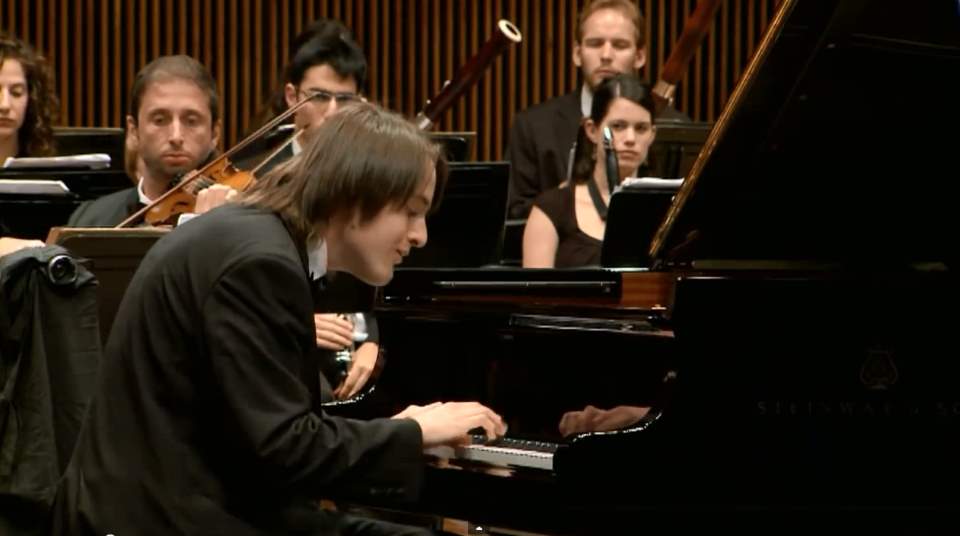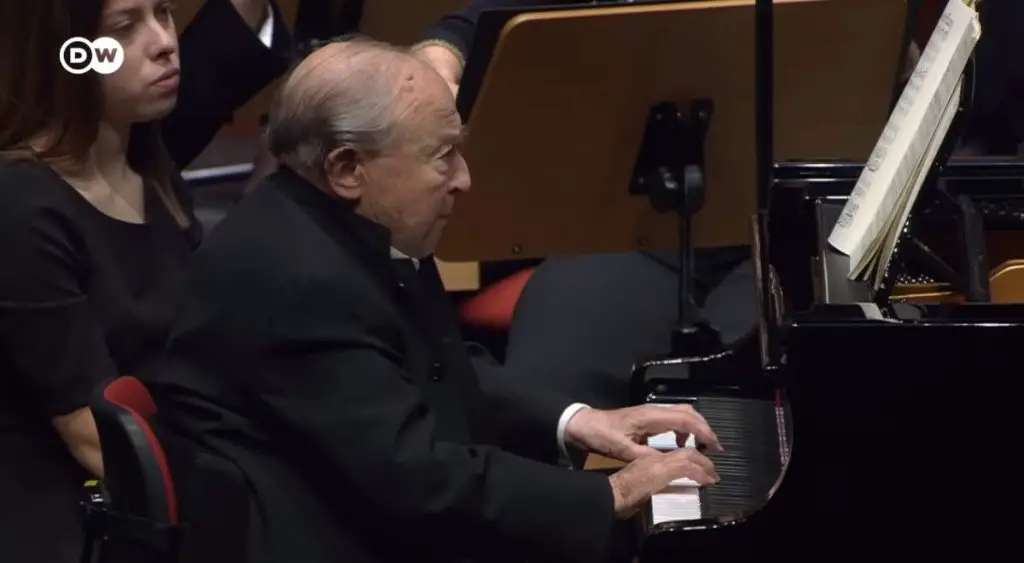Accompanied by the Israel Camerata Orchestra, Russian concert pianist and composer Daniil Trifonov plays Wolfgang Amadeus Mozart’s Piano Concerto No. 23 in A major, K. 488 at the 13th Arthur Rubinstein Piano Master Competition in Tel Aviv. Conductor: Avner Biron. Trifonov won the First Prize.
Mozart’s Piano Concerto No. 23
Mozart’s Piano Concerto No. 23 in A major, K. 488 is one of his most popular piano concertos, and one of the most frequently performed and recorded works in the entire classical repertoire. The concerto was composed in 1786, during a particularly productive period in Mozart’s career, and was first performed by the composer himself in Vienna in March of that year.
According to Mozart’s own catalog, the work was completed on March 2, 1786, around the time of the premiere of his opera, The Marriage of Figaro. And most likely played the first performance a few days later in Vienna. On the whole, the last six of the twelve piano concertos that Mozart wrote between 1784 and 1786 are conceived on a bigger scale than the earlier ones – many of which were designed for favorite pupils, but the A major concerto K488 is an exception, for in this the most lyrical of all the concertos Mozart dispenses with trumpets and drums and uses clarinets in place of oboes.
The concerto has three movements:
- Allegro in A major and common time. The first movement of Mozart’s Piano Concerto No. 23 in A major, K. 488 is a lively and exuberant piece of music that sets the tone for the entire concerto. It is in a sonata-allegro form, which is a common form for the first movements of classical-era concertos and symphonies. The movement begins with an orchestral introduction that establishes the key and mood of the piece. The piano then enters with the main theme, which is characterized by a singing melody and flowing accompaniment. The theme is then developed and elaborated upon, with the piano and orchestra taking turns playing and expanding upon the melodic material. As the movement progresses, Mozart introduces a second theme that provides a contrast to the first. This second theme is more stately and reserved and features a dotted rhythm that gives it a regal character. The two themes are then developed and combined in various ways, with the piano and orchestra trading off the melodic material and engaging in lively dialogue. The first movement also features a development section, where Mozart takes the themes from the exposition and subjects them to various manipulations and transformations. This section builds tension and excitement, leading up to the recapitulation, where the themes from the exposition are restated in their original form.
- Adagio in F-sharp minor and 6/8 time (in later editions, the tempo is listed as Andante). The second movement of the concerto is a beautiful and expressive Adagio in F-sharp minor. It begins with a hauntingly lyrical melody played by the piano, accompanied by the orchestra. This melody is then repeated and developed throughout the movement, with the piano and orchestra engaging in a musical dialogue that is both dramatic and tender. The central section of the movement features a more animated and virtuosic piano part, with a faster tempo and intricate figurations. This section provides a striking contrast to the more introspective opening theme and showcases the technical brilliance of Mozart’s writing for the piano. The movement eventually returns to the opening theme, which is played with even greater depth and intensity than before. The final chords of the movement are subdued and melancholic, leaving the listener with a sense of wistful nostalgia.
- Allegro assai in A and alla breve (in later editions, the tempo is listed as Presto). In Rondo form. The finale of Mozart’s Piano Concerto No. 23 is a lively and energetic rondo, marked Allegro assai, which means “very fast.” The movement begins with a quick introduction by the orchestra, followed by the piano’s entrance with a joyful and virtuosic theme. The theme is then developed through a series of variations, showcasing the soloist’s technical skill and musicality. The middle section of the movement features a contrasting melody, played first by the woodwinds and then by the piano. This section provides a moment of repose before the energetic rondo theme returns, leading to a brilliant and triumphant conclusion. One of the most striking features of this movement is the way in which Mozart combines technical brilliance with expressive depth. The virtuosic passages are not just flashy displays of skill but are imbued with emotion and meaning, creating a sense of drama and intensity that is characteristic of Mozart’s music.
Daniil Trifonov
Daniil Olegovich Trifonov (born March 5, 1991 in Nizhny Novgorod) is a Russian concert pianist and composer. At 17, he won Fifth Prize at the 4th International Scriabin Competition in Moscow, and the First Prize at the 3rd International Piano Competition of San Marino, where he also received the Special Prize for the best performance of Chick Corea’s composition.

In 2010, he played at the Rathausplatz in Vienna’s Town Hall Square as one of the seven finalists of the Eurovision Young Musicians. In 2010, Trifonov became a medalist in the distinguished XVI International Chopin Piano Competition in Warsaw, where he won the Third Prize and the Special Prize of Polish Radio for the best mazurka performance.
In 2011, he won the First Prize at the 13th Arthur Rubinstein International Piano Master Competition in Tel Aviv, winning also the Pnina Salzman Prize for the Best Performer of a Chopin piece, the Prize for the Best Performer of Chamber Music and the Audience Favorite Prize.
A few weeks after winning the Rubinstein Competition, Trifonov was awarded the First Prize, Gold Medal, and Grand Prix at the XIV International Tchaikovsky Competition in Moscow. Trifonov also won the Audience Award and the Award for Best Performance of a Chamber Concerto.
Israel Camerata Orchestra
The Israel Camerata Orchestra Jerusalem is the leading chamber orchestra in Israel today. The Camerata was founded in 1983 by Avner Biron, who has been its music director and permanent conductor since then.
The orchestra performs more than 100 concerts a year in Israel and abroad. Its activities include subscribers’ series, festivals, special concerts, and unique educational projects all over the country.
The Camerata’s repertoire ranges from Baroque to contemporary music. In addition to the traditional repertoire the Camerata is involved in performances of unknown and newly discovered music of different periods as well as performing premiers of contemporary works, Israeli music, and works were written especially for Avner Biron and the Camerata.
Sources
- Piano Concerto No. 23 (Mozart) on wikipedia
- Piano Concerto No. 23 in A major, K. 488 on AllMusic.com
- Mozart Piano Concerto no. 23 in A Major K 488 on BHCO
- Daniil Trifonov on wikipedia
- Israel Camerata Orchestra Jerusalem (Chamber Orchestra) on Bach-Cantatas.com


